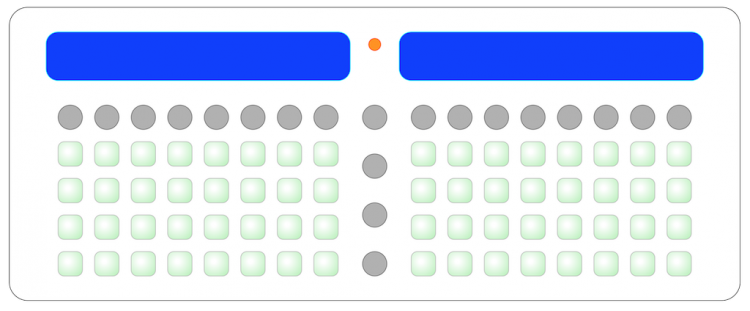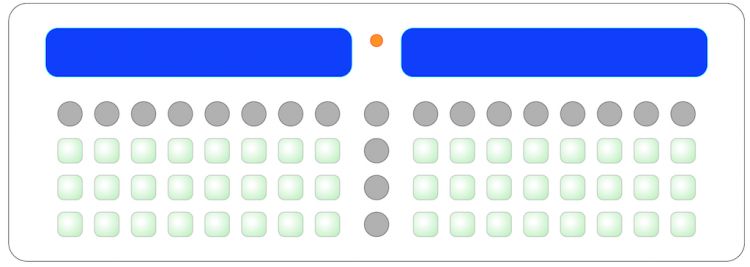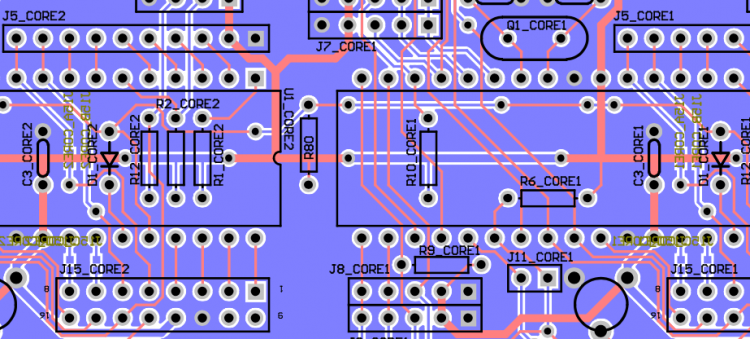-
Posts
15,247 -
Joined
Content Type
Profiles
Forums
Blogs
Gallery
Everything posted by TK.
-
It's still on the wishlist, which means that it will be implemented (sooner or later) Best Regards, Thorsten.
-
I think that additional buttons will be required, maybe above the Jog Shuttle. They would allow to switch the keyboard into different modes, such as 1 button to select the "normal layout", the 4th row (which is not available on Wilbas frontpanel) is used to select tracks 1 button so that the 4th row is used for mutes 1 button so that the 4th row is used to select parameter layers 1 button so that the 4th row is used to select trigger layers 4 buttons to switch to BLM mode and to select the 4x16 segment maybe some spares if space is available Best Regards, Thorsten.
-
I remember that I ordered this chip some time ago to work on a Dual-MBHP_IIC_MIDI board, but I'm still unsure if it's worth to work on this. Implementation, documentation and support effort is higher than the benefit (at least at my side) Actually it would be nice if somebody else could implement an alternative solution, do all the required testing and give long-term support. Best Regards, Thorsten.
-
I'm in contact with the designer. The good news: he plans a public release of all sources, which means that it will be possible to change the HW interface so that it can be directly connected to the core w/o need for serial shift registers! It might even be possible to use a bigger FPGA for the emulation of 8 SIDs, all connected to a single SPI which will be the best way how to control the SIDs from a MBHP_CORE_STM32F4 module. Best Regards, Thorsten.
-
WS2812B is possible for V4+, but the LEDs consume so much power that the device can't be supplied from a USB cable (strongly recommended todays!) Best Regards, Thorsten.
-
Zoom control is still on the agenda... ;) If layout of 4x16 RGB LEDs is problematic, I would prefer 4x16 duo colour Best Regards, Thorsten.
-
No problem, button matrix could also be 4x16: In order to switch between different modes (common button assignments, BLM) a special button will be required. The encoder switches could be used for this purpose Best Regards, Thorsten.
-
Btw.: advantage of the stickers - people can customize them easily if they prefer different button assignments The font should be transparent Best Regards, Thorsten.
-
Or stickers on top of the pads, see example from Novation: Best Regards, Thorsten.
-
Iluminated button caps: DIY! -> Best Regards, Thorsten.
-
Encoders are important for fast parameter changes with a single hand. Here an alternative idea for a FP layout: However, a potential issue with the adafruit pads is the spacing between the pads: it doesn't allow to add labels But labels are essential for intuitive usage! Best Regards, Thorsten.
-
@mongrol was the OLED working before? I just tested a MB997D with two common CLCDs - they are working (tested with MBSEQV4) Best Regards, Thorsten.
-
Great build, and really worth the money! Best Regards, Thorsten.
-
Hopefully it will be possible to find a more detailed datasheet. Maybe it isn't related to current draw, but to a configuration option. This is based on speculation, but worth to check (because I've no other idea): according to the website this display supports different protocols such as 6800, 8080 and SPI. The 8080 protocol is required, if 6800 is selected instead, a short circuit would happen between the parallel connected data busses during read operations, and this could cause a malfunction (e.g. core reboot) With some luck you will find some bridges on the PCB which show the configurable options on the silk screen. Best Regards, Thorsten.
-
Could you please provide a link to the datasheet of this display? Best Regards, Thorsten.
-
-
Cheers! Best Regards, Thorsten.
-
Cool! Best Regards, Thorsten.
-
So, you mount the 4 PICs of the non-working board into the other board, and CAN communication is working there? This is an important information! Concerning continuity checks: remove the PICs while checking it. Compare with this interconnection diagram: http://www.ucapps.de/midibox_sid/mbsid_v2_communication.pdf And this schematic: http://www.ucapps.de/mbhp/mbhp_core_v3.pdf Expectations: pins #36 of the PICs (RB3) are directly connected together. They should show continuity to each other. No continuity to ground (Vs) No continuity to 5V (Vd) But should show 1k resistance to Vd pin #35 of the PICs (RB2) should show No continuity to ground (Vs) No continuity to 5V (Vd) continuity to pin #36 only if the negative probe is connected to pin #35, and the positive probe to pin #36 (due to the diode) Results? Best Regards, Thorsten.
-
Synced pattern changes should work again with this version: -> http://www.ucapps.de/mios32/midibox_seq_v4_092_pre7.zip Background why this happened: last week I analyzed the stack usage and found out, that in worst case a stack overrun could happen while playing MIDI events or operating with the CS. I gave the appr. tasks more memory, and reduced memory for the pattern handler. By doing so, I overlooked that during a pattern change more memory will be allocated than expected. With the last changes the pattern task became obsolete, giving more memory for the other tasks (and a bit more memory for additional features :) I hope that with pre7 everything is working like before (or even better ;-) Best Regards, Thorsten.
-
Ooops! Thanks for the hint - it should work again with this version: -> http://www.ucapps.de/mios32/midibox_seq_v4_092_pre6.zip Best Regards, Thorsten.
-
You've to enable the "sync to track" option for both tracks, and they have to run with the same divider, then it will work! :) Here the new version: -> http://www.ucapps.de/mios32/midibox_seq_v4_092_pre5.zip You are right, I corrected the max. trigger layer lengths of the two additional drum modes that you introduced accordingly in pre5 Best Regards, Thorsten.
-
Alright, here some updates: -> http://www.ucapps.de/mios32/midibox_seq_v4_092_pre5.zip /edit: corrected to newer link o new drum configurations: 4*16/2*64, 4*16/1*128, 4*16/1*256 o new track mode configuration option: "Note" Allows to specify, if the transposer should take the last or first played note (previously it always played the last note) o individual steps of CC, PitchBender, Program Change and Aftertouch layers can now be disabled so that they won't play. Turn the encoder to the rightmost position (value 128) Also the init value has been changed: for these layers, the steps are now disabled by default. For CCs please change the init value by yourself in the UTIL->OPT page (option #12: Initial CC value) o new behaviour of CLEAR button in recording mode: it clears the selected step only (not the entire pattern). During live recording it will clear the "played" steps so long the button is pressed. o new CC functions which can be configured in MIDI->ExtCtrl.: o Play/Stop: allows to assign the PLAY button to a CC o Record: allows to assign the RECORD button to a CC @EsotericLabs: thanks a lot for testing! G1T2 was playing the last note of the note stack. Since G1T1 played a chord into the transposer but, it was off the root note. In the new version you are able to specify that the first note should be played. Select Track #2, change to the MODE page and press GP button #9 @u-link: - request #1 implemented (I also needed it ;-) - request #2 was already implemented (there is a BUTTON_RECORD and LED_RECORD option in the MBSEQ_HW.V4 file, please update your file according to the templates under hwcfg/*) However, Play/Stop and Record can now also controlled via CC (e.g. to control these functions from a foot switch) - request #3: implemented (yes, it makes sense) - request #4: statement & question: I'm using custom groove patterns to vary the velocity, here I would like to control each 16th In addition, since groove patterns can be applied globally, you want to define them independent of the track divider However, what I could add is an option which allows to synchronize the groove pattern to the track step instead of the global step. Would this satisfy your request? Best Regards, Thorsten.
-
Ich habe in den letzten Tagen auf eine neue FreeRTOS Version umgestellt, dabei habe ich vergessen ein wichtiges Feature fuer den LPC17 zu aktivieren... Update nochmal das repository, es sollte nun funktionieren. Gruss, Thorsten.
-
Alright, the problem with the chord display was, that it actually always displayed a label based on the first layer (and not the selected layer). This is fixed now. -> http://www.ucapps.de/mios32/midibox_seq_v4_092_pre3.zip I also added the support for 4 parameter layers in drum tracks. The implementation wasn't so difficult. Would be nice if you could help testing (also the other layer modes to ensure that I haven't corrupted something) Best Regards, Thorsten.





